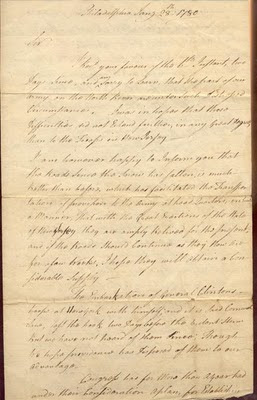As we continue to pick our way through snow and slush on the streets of Philadelphia our librarian Elizabeth Fuller just pointed me to a great winter letter from William Floyd to George Clinton on January 28, 1780. Floyd was serving in the Continental Congress in Philadelphia, while Clinton was governor of New York.
At the beginning of the letter Floyd responds to Clinton’s concerns about provisioning troops stationed at the North River in New York. Floyd is upset to hear that they are in distress, but notes optimistically that “I am happy to inform you that the roads since the snow has fallen, is much better than before, which has facilitated the transportation of provisions to the army at Headquarters, in such a manner that with the great exertions of the state of New Jersey they are amply relieved for the instant; and if the roads should continue as they now are for a few weeks I hope they will obtain a considerable supply.” In the 18th-century, snowfall on the roads was actually a GOOD thing, since it could allow the use of sleds and when packed down would create a better surface than the mud and slush that were typical on the unpaved roads.
The Headquarters Floyd speaks of was the encampment in Morristown, New Jersey, now a historic site. It is good that supplies were finally reaching them, since the situation was quite dire. On January 8, George Washington had sent out a letter to the magistrates of New Jersey asking for supplies, because“The present situation of the army with respect to provision, is the most distressing of any we have experienced since the beginning of the war. For a fortnight (two weeks) past the troops, both officers and men, have been almost perishing for want. They have been alternately without bread or meat the whole time, with a very scanty allowance of either and frequently destitute of both. They have borne their sufferings with a patience that merits the approbation and ought excite the sympathy of their Countrymen.”
For more on the Hard Winter of 1779-1780, which was actually worse than the famous Valley Forge experience of 1777-78, check out this NJN documentary–the website has lots of useful info and the documentary itself will air several times next week. (Although, even if Valley Forge can’t win the weather award I do want to congratulate them on the fantastic Washington’s birthday celebration which I attended on Monday with my 5 year old. It was one of the best family day programs I’ve attended anywhere in a long time and it even came with real birthday cake baked according to Martha’s recipe!)
Back to Floyd. After conveying a bunch of news about the Congress, Floyd gives an update on the weather in Philadelphia. He says that the past five weeks have been the coldest that anyone can remember since “the year 40” and notes that “last week an ox was roasted on the river and I am told the ice is now 2 foot thick.” By the river, Floyd means the Delaware River and when I read this I was shocked–could the Delaware really have frozen over 2 feet deep? But a quick check indicated that yes, in the amazingly cold winter of 1780, not only did the Delaware freeze, but the Chesapeake Bay froze over at Annapolis and Long Island Sound froze over as well. Boy am I glad I wasn’t around for that winter–especially since it was in the era of fireplace heating, which meant that temperatures indoors wouldn’t have been too much better than those outside. Brrrrr!


